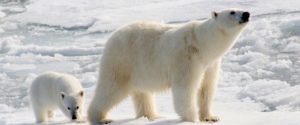RESOURCES
Big Idea: Biodiversity

Biodiversity refers to the importance of having a large number of different species of animals, plants and microorganisms to the survival of all species. In a diverse ecosystem all species have an important role to play in boosting the efficiency of an ecosystem and protecting overall sustainability. Healthy and diverse ecosystems can better withstand and recover from disasters.
Everything on earth is interconnected. Polar bears represent an important piece of our interconnected environment. Polar Bears International (PBI) is dedicated to assuring the survival of the polar bear. Pollution and climate change threaten this magnificent species, but there is still hope. PBI challenges you to reduce your school, household or community carbon footprint.
ENGAGE
Big Idea: Biodiversity
Essential Question: How can we protect biodiversity?
Challenge: Reduce your carbon footprint!
Sample Guiding Questions
These are only example questions we encourage you to ask as many personal and contextual questions as possible.
- What is biodiversity?
- How do we impact biodiversity?
- Why is biodiversity important?
- What is a carbon footprint?
- How does increased CO2 and/or climate change impact biodiversity?
- Etc.
*Once you brainstorm all of the questions organize and prioritize them.
INVESTIGATE
Guiding Activities and Resources
These are only a set of example activities and resources and the learners will need to evaluate the quality of the content. They are not verified or necessarily supported, just examples. The ones that you choose should be in direct relationship to your specific guiding questions and context. Activities and resources for adults, adolescents, and younger children will be different. The goal is to develop solutions that mean something in your community and are sustainable.
Example Activities
- Understand the vocabulary biodiversity, climate change, carbon footprint, etc.
- Interview biodiversity experts (local and remote)
- Research the causes of climate change
- Audit your personal, family, school and community use of resources.
- Calculate your personal and family carbon footprints.
- Research the most effective actions for reducing greenhouse gas emissions.
- Explore the impact of local, state and federal laws on reducing greenhouse gas emissions.
- Research the environmental platforms of your local, state and federal representatives.
- Explore the websites and if possible visit one of the Arctic Ambassador Centers.
- Etc.
Example Resources
- Polar Bears International.
- Arctic Ambassador Centers.
- Carbon Footprint
- The Nature Conservancy
- American Museum of Natural History
- Etc.
Synthesis
Using the research findings from your Investigations develop a synthesis that demonstrates a clear understanding of the challenge. For help with creating a synthesis explore this resource.
Solution Prototypes – Using your research synthesis create multiple ideas for solutions and review each one to make sure your research supports it. Share the prototypes with various stakeholders and get feedback.
Solution – with the feedback from the stakeholders develop one solution that has the most potential for success.
ACT
Implement – Develop a plan to implement the solution with the stakeholders and collect data about the impact.
Evaluate – Using quantitative and qualitative measures determine if the solution is valid and what can be improved.
REFLECT, DOCUMENT, AND SHARE
Throughout the experience take time to document the events and reflect on what is happening to build on prior knowledge and identify future questions.
Share what you learned with your local community and the world. Use #CBLWorld on social media.
